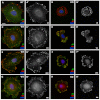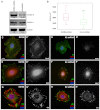Functional differences between kindlin-1 and kindlin-2 in keratinocytes
- PMID: 22328497
- PMCID: PMC3367939
- DOI: 10.1242/jcs.096214
Functional differences between kindlin-1 and kindlin-2 in keratinocytes
Abstract
Integrin-β1-null keratinocytes can adhere to fibronectin through integrin αvβ6, but form large peripheral focal adhesions and exhibit defective cell spreading. Here we report that, in addition to the reduced avidity of αvβ6 integrin binding to fibronectin, the inability of integrin β6 to efficiently bind and recruit kindlin-2 to focal adhesions directly contributes to these phenotypes. Kindlins regulate integrins through direct interactions with the integrin-β cytoplasmic tail and keratinocytes express kindlin-1 and kindlin-2. Notably, although both kindlins localize to focal adhesions in wild-type cells, only kindlin-1 localizes to the integrin-β6-rich adhesions of integrin-β1-null cells. Rescue of these cells with wild-type and chimeric integrin constructs revealed a correlation between kindlin-2 recruitment and cell spreading. Furthermore, despite the presence of kindlin-1, knockdown of kindlin-2 in wild-type keratinocytes impaired cell spreading. Our data reveal unexpected functional consequences of differences in the association of two homologous kindlin isoforms with two closely related integrins, and suggest that despite their similarities, different kindlins are likely to have unique functions.
Figures








References
-
- Ashton G. H., McLean W. H., South A. P., Oyama N., Smith F. J., Al-Suwaid R., Al-Ismaily A., Atherton D. J., Harwood C. A., Leigh I. M., et al. (2004). Recurrent mutations in kindlin-1, a novel keratinocyte focal contact protein, in the autosomal recessive skin fragility and photosensitivity disorder, Kindler syndrome. J. Invest. Dermatol. 122, 78-83 - PubMed
-
- Brakebusch C., Fässler R. (2005). beta 1 integrin function in vivo: adhesion, migration and more. Cancer Metastasis Rev. 24, 403-411 - PubMed
Publication types
MeSH terms
Substances
Grants and funding
LinkOut - more resources
Full Text Sources

